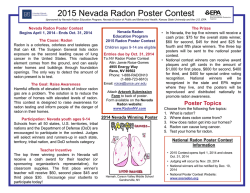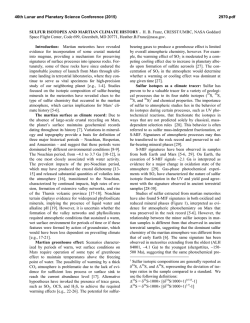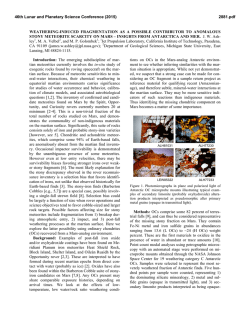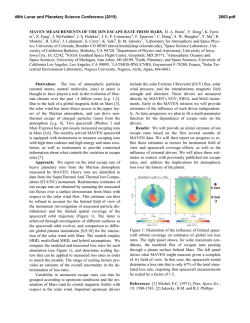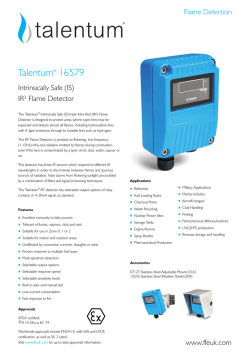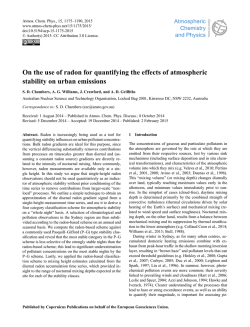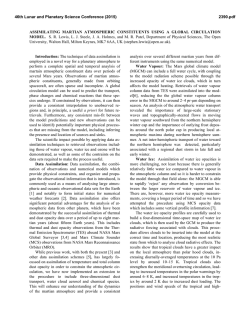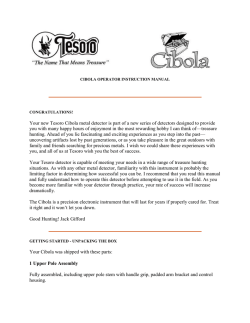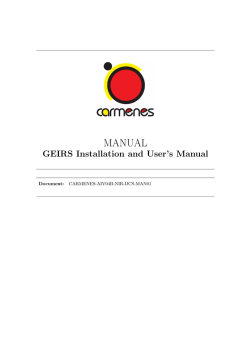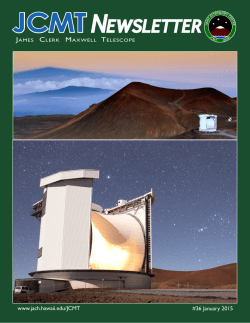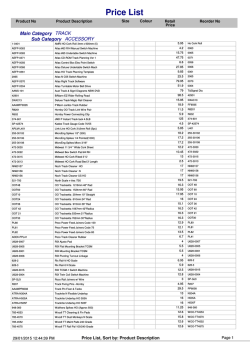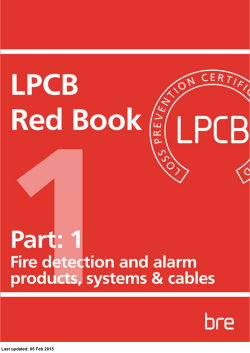
Measuring Atmospheric Radon with the RAD Instrument Onboard
46th Lunar and Planetary Science Conference (2015) 2842.pdf MEASURING ATMOSPHERIC RADON WITH THE RAD INSTRUMENT ONBOARD CURIOSITY. P.-Y. Meslin1, C. Zeitlin2, D. M. Hassler2,3, R. F. Wimmer-Schweingruber4, B. Ehresmann2, J. Guo4, S. Böttcher4, J. Köhler4, D. E. Brinza5. 1IRAP, Univ. Paul Sabatier, OMP/CNRS, 31400 Toulouse, France (pmeslin at irap.omp.eu). 2 Southwest Research Institute, Boulder, CO, USA, 3Institut d’Astrophysique Spatiale, Univ. Paris-Sud, Orsay, France. 4Institute for Experimental and Applied Physics, Christian-Albrechts-University Kiel, Kiel, Germany. 5Jet Propulsion Laboratory, Pasadena, CA, USA. Introduction: The detection of atmospheric trace gases, the characterization of their spatial and temporal variations, and the localization of their sources have become key objectives of the Martian exploration program. In particular, the 2016 Trace Gas Orbiter mission (TGO) will be specifically devoted to these goals. Moreover, the recent detection of a ten-fold increase in methane concentration over a 60-sol time period by the Tunable Laser Spectrometer (TLS) of the Sample Analysis at Mars (SAM) instrument suite on Curiosity [1] has reinvigorated and reinforced former claims of detection of large spatial and temporal variations of this gas in the Martian atmosphere by terrestrial and orbital observations [2-5], which so far have defied explanation. If the loss mechanisms responsible for the seemingly short atmospheric lifetime of methane are still unknown, the existence of local and episodic sources of methane is also puzzling. As diffusion processes are unlikely to induce rapid fluctuations of methane injection into the atmosphere, such fluctuations may result from local venting of subsurface gases, for instance following the disruption of subsurface reservoirs of gases or clathrates by impacts or seismic events. If this type of events were to occur, other gases would probably also be outgassed concommitently. This is certainly true for radon-222, a radioactive gas produced in the subsurface by the decay of uranium238 (Fig. 1). For instance, it has been suggested that the 222Rn and 210Po anomalies observed at the surface of the Moon have been triggered by moonquakes [6, 7]. In this process, radon would probably follow 40Ar, whose injection into the lunar exosphere is also believed to be controlled by moonquakes [8]. An advantage of radon-222 is its relatively short lifetime of 3.8 days, which places strong constraints on the location of the outgassing site, if a radon anomaly were also to be detected. Therefore, radon is an interesting tracer of the current outgassing activity of a planet. The presence of radon in the Martian atmosphere has already been inferred from the presence of unsupported polonium-210 on atmospheric dust by Opportunity APXS [9], and later by Spirit APXS [10]. A preliminary map of atmospheric radon has also been derived from the analysis of the 214Bi and 214Pb lines in the gamma-ray spectra acquired by Mars Odyssey Gamma Ray Spectrometer [11]. However, radon itself has never been directly measured at the surface of Mars, and in situ measurements would provide very useful ground truth for orbital measurements, which could in turn be used to search for local and temporal anomalies of radon, possibly associated with methane emissions. Here we show how the RAD instrument (Radiation Assessment Detector) onboard Curiosity is capable of providing the first direct measurement of radon in the martian atmosphere, or at least to provide an upper limit if its concentration is too low. Preliminary results will be shown at the conference. Description of the method: The RAD instrument is an energetic particle detector designed to measure a broad spectrum of energetic particle radiation and to make the first direct radiation measurements on the surface of Mars, detecting galactic cosmic rays, solar energetic particles, secondary neutrons, and other secondary particles created both in the atmosphere and in the Martian regolith [12]. Its ability to measure charged particles with 300 m-thick silicon pi-n diodes or PIPS (Passivated Implanted Planar Silicon) detectors makes it capable in theory of measuring alpha particles emitted by 222Rn and 220Rn, two radon isotopes with very different half-lives (3.8 days and 55 seconds, respectively), as well as some of their shortlived decay products (Fig. 1 and 2). Fig. 1. Uranium-238 decay chain (with decay mode, half-life and energy). The alpha-emitters used to measure radon-222 are marked in red. 46th Lunar and Planetary Science Conference (2015) Thorium-232 decay chain Fig. 2. Thorium-232 decay chain (with decay mode, half-life and energy). The alpha-emitters used to measure radon-220 are marked in red. The upper part of RAD consists of a 5 cm-high cylinder that separates two PIPS detectors (detector A and B) (Fig. 1), which together form a telescope for charged-particles detection in a view-cone of about 60° full opening angle. Unfortunately, a foil covering detector A prevents low energy alpha particles emitted from outside (and hence, radon) to be recorded. Volume filled with atmospheric 222Rn Internal surface covered by 218Po and 214Po Detector B Fig. 3. Schematic diagram of RAD, showing the telescope assembly of the silicon detectors A and B and the volume filled with atmospheric radon inbetween. The height of the telescope cylinder is ~5 cm. Modified from [12]. However, the pressure inside the telescope cylinder is equilibrated with the ambient pressure (through the rover’s body interior, a thin slit and then through thin (~1mm diameter) and longish (~2cm) bore holes into the connectors compartment). Although this quite long path probably prevents 220Rn from diffusing efficiently into this volume, 222Rn concentration in this volume is expected to be the roughly the same as that in the sur- 2842.pdf rounding air. Once in the telescope cylinder, it will decay and its short-lived decay products (218Po and 214 Po), which are nanometer-sized aerosols, will adhere to the internal surface of the telescope. Detector B will then record alpha particles emitted by these three radionuclides, at 5.5, 6 and 7.7 MeV, respectively. The lower, uncovered face of Detector A cannot be used, as the events are recorded only if also detected by Detector B. More than two years of operations at the surface of Mars (with a duty cycle of nearly 100% for RAD) should compensate for the very small working volume, which allows only a very small activity to be present inside (210-4 Bq, assuming an air concentration 0.5 Bq.m-3 consistent with orbital measurements). Precise estimation of the detection efficiency of detector B with respect to a homogeneous volume (222Rn) and surface (218Po, 214Po) distribution of radionuclides in the telescope cylinder, together with long integration of the background signal in neighboring energy channels will allow us to derive a detection threshold for the instrument and to derive an upper limit for 222Rn concentration, in case no statistically significant signal is found at the energies of interest. Perspectives: RAD provides a unique opportunity to measure directly the concentration of radon-222 at the surface of Mars, or at least to provide an upper limit, which will gradually decrease over time. This is important for the confirmation of the global distribution map derived by Mars Odyssey [11]. Radon is an interesting radionuclide to investigate the transport of gaseous species, both in the soil and in the atmosphere, but also to study the water and dust cycles [10, 11, 13]. Finally, day/night variations in RAD data could also provide insight into the dynamics of the planetary boundary layer, as done for the Earth’s atmosphere [e.g., 14]. References: [1] Webster et al. (2014), Science. [2] Formisano et al. (2004), Science 306, 1758–1761. [3] Krasnopolsky et al. (2004), Icarus 172, 537-547. [4] Mumma et al. (2009), Science 323, 1041–1045. [5] Fonti and Marzo (2010), Astron. Astrophys, 512, A51. [6] Bjorkholm et al. (1973), Science, 180 (4089), 957959 [7] Crotts (2008), ApJ, 687(1), 692-705. [8] Hodges (1977), Physics of the Earth and Planetary Interiors, 14(3), 282-288. [9] Meslin, P.-Y. et al. (2006), JGR, 111(E9). [10] Meslin et al. (2014), “Mars atmosphere: Modeling and Observation” Conference, held in Oxford. [11] Meslin et al. (2012), 43rd LPSC, abstr. #2852. [12] Hassler et al. (2012), Space Sci Rev., 170, 503-558. [13] Meslin, P.-Y. (2008), PhD thesis, Université Pierre et Marie Curie/IRSN. [14] Cohen et al., 1972, JGR 77(15).
© Copyright 2025


